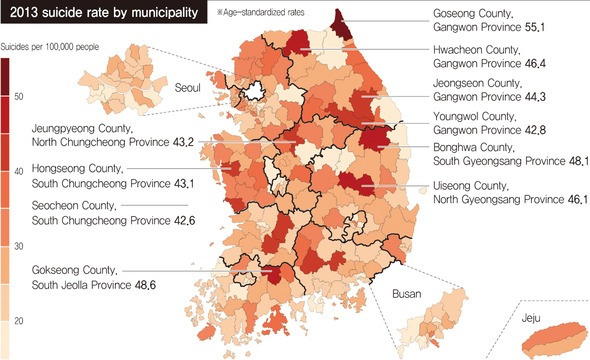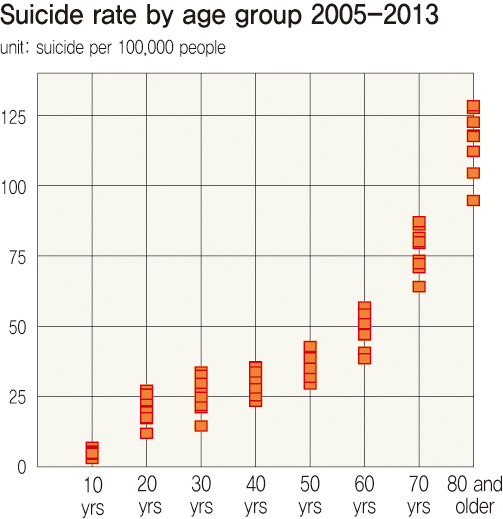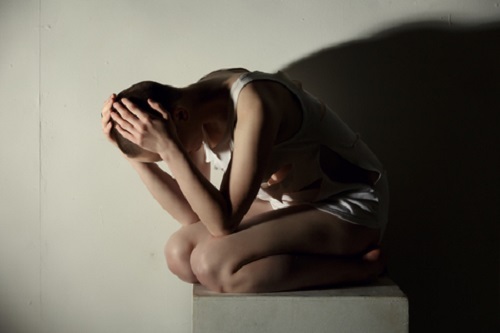Suicide rate polarizing according to age and region (hankyoreh)
Suicide more common among elderly in fading rural communities
 |
|
2013 suicide rate by municipality
|
South Korea has OECD’s highest rate, and suicides more common among elderly in fading rural communities
The South Korean suicide rate, which consistently ranks as one of the world’s highest, also shows signs of serious polarization according to age group and region, statistics indicate.An
Oct. 21 analysis of cause of death data for 2005 to 2013 from Statistics Korea showed the suicide rate among South Koreans aged 80 and older to be anywhere from five to seven times higher than the rate for those aged 20 and 29 at points during the nine-year period.
Figures showing age-standardized rates for regions also showed some farming communities to have rates as much as five times higher than in large cities. Age-standardized rates correct for differing suicide rates by age group and thus is not affected by age distribution, including the overall percentage of senior citizens in the population.
According to the data, suicide rates rose with age. Between 2005 and 2012, the rate in the 80-and-older population stood at over 100 suicides per 100,000 people, falling to 94.7 only last year. The rate for those aged 70 to 79 also stood between 70 and 84 for the eight-year period before falling to 66.9 in 2013.
The suicide rate among South Korea’s senior citizens was calculated at nearly four times the average for OECD member countries. For those aged 20 to 29, the rate consistently ranged between 18 to 25 per 100,000. Among those aged 30 to 39, it showed a steady increase from 21.8 in 2005 to 28.4 in 2013.
Regional disparities were equally severe. Rates were consistently high for the provinces of Gangwon, South Chungcheong, and North Chungcheong, with respective 2013 age-standardized suicide rates of 32, 30.3, and 29.3 per 100,000 people. The rates for Seoul (22.6) and Ulsan (23.6) were roughly 10 suicides per 100,000 people lower.
An even sharper picture emerged in terms of differences between urban and rural communities. By the standard of simple average age-standardized suicide rate for 2005–2013, the top ten ranking municipalities had rates averaging 40.9 per 100,000 residents. For the bottom ten, the average was just 17.9.
 |
|
Suicide rate by age group 2005-2013
|
By nine-year average, the top ten municipalities were, in order, Jeongseon and Yeongwol counties in Gangwon; Cheongyang County, South Chungcheong Province; Yangyang County, Gangwon Province; Goesan County, North Chungcheong Province, Hongcheon County, Gangwon Province; Taean County, South Chungcheong Province, Uiseong County, North Gyeongsang Province; Cheorwon County, Gangwon Province; and Seosan County, South Chungcheong Province. With the exception of Seosan, all of the communities have declining populations, with many senior residents who have had to keep working.
The analysis also found the South Korean suicide rate dropping when the birth rate or growth rate were high, and rising when the divorce rate or income inequality (Gini coefficient) increased. The trend was confirmed by a National Assembly Budget Office analysis of correlations between the suicide rate and various socioeconomic factors between 1990 and 2012. It indicates that deepening social inequality and changing of traditional family structures have led to more suicides.
Original Article : http://bit.ly/2slGq3S

